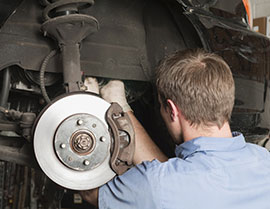
One of Camarillo Car Care Center’s
Technicians performing a brake inspection.
Just as your gas mileage will vary depending on where and how you drive, so it goes with the life of brake pads. Brake pads or linings are the friction material that is pressed against a metal disc or drum to stop your vehicle.
If you drive only 8,000 miles a year mainly in a crowded urban area, such as Los Angeles, you will need to replace brake pads more often than someone who drives 28,000 miles a year across the flatlands of Nebraska. You use your brakes a lot more in urban driving than on a rural highway.
Unfortunately, there is no clear-cut schedule that tells you when it's time to replace the brakes. You need to rely on your ears and the advice of an experienced automotive technician. A good time to have brakes inspected is during a routine tire rotation which for most vehicles is at least every six months. A technician can check the thickness of the pads and the condition of the brake hardware to spot deterioration.
Many cars have built-in wear sensors that scrape against a brake disc when the linings needed replacing. The driver will hear an annoying screeching sound when they apply the brakes (or when the brakes are released on some vehicles).
Those sensors are not on every vehicle, so drivers should listen for squeaks, squeals, grinding noises (often a sign that brake pads are entirely gone), and other noises that indicate wear. Some minor noises can be eliminated by cleaning the brakes, but persistent, prominent noises usually mean parts are worn. Other signs include pulsations through the brake pedal, longer stopping distances, or when you apply the brakes your foot goes down further and closer to the floor. Brake linings wear gradually and you may not notice the demise in performance, so an experienced eye of a technician can help diagnose the need for brake replacement.
All cars have a brake warning light that comes on for a few seconds every time you start your car. If it appears while driving, that usually means your brake system is low on fluid, it could have developed a leak, or a problem with the brake master cylinder. Note that this is not the same warning light that comes on when you apply the hand/foot-operated parking brake.
Most cars and light trucks usually have front disc brakes. Most have rear discs, as well, though some lower-priced cars still come with rear drum brakes. With discs, it is a common practice to replace the brake pads and resurface the rotors on a lathe so the mating surfaces between the new brakes is even and smooth.
In recent years, however, more automakers have switched to rotors that are lighter and thinner to reduce overall weight, to save money, and to try to obtain better fuel economy (the lighter the vehicle weight, the better fuel economy). Discs in the past would last through two or three resurfacings, but don't be surprised if you need new rotors when you replace your pads. The current ones may not have enough material to be shaved off in resurfacing and may not be as durable as those from 10 or more years ago. In addition, top repair shops will resurface rotors using a lathe that bolts up to your vehicle and cuts them on the car. This technique gives the rotors the most accurate and true cut reducing the risk for noises and pulsations.
If you’ve noticed unusual noises happening when you apply your brakes, now would be the time to bring your vehicle to an automotive professional like Camarillo Car Care Center for a complete comprehensive brake inspection. They’ll be happy to perform an inspection and physically show you the results on your car.